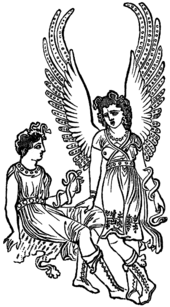Erinyes
![]()
Furie is a redirect to this article. For other meanings, see Furie (disambiguation).
The Erinyes or Erinyes (ancient Greek Ἐρινύες, in the singular Ἐρινύς Erinys; Latin Erinys, Erinnys) - also known to the Greeks as Μανίαι Maniai, "the frenzied", later as the Eumenides (Εὐμενίδες), and to the Romans as the Furies (furiae, from furia "rage, frenzy") - are three vengeful goddesses in Greek mythology:
- Alekto (Ἀληκτώ), "the (in her hunt) unceasing".
- Megaira (Μέγαιρα, German also "Megäre"), "the envious anger".
- Tisiphone (Τισιφόνη, also Τεισιφόνη Teisiphone), "the retaliator" or "the one who avenges murder". She is often depicted on Greek amphorae with a dog's head and bat wings.
They represent the personified remorse. In the matriarchal context, they are considered defenders of matriarchal principles. They are associated with the cult of the dead and fertility.
The name Eumenides, the well-meaning, was given to them after Aeschylus' The Eumenides as a result of the trial of Orestes, after they had lost their office and power. This renaming is seen as a placatory-defensive euphemism, indicating the historical change to the patriarchal principle that took place in the Oresteia.
The term "fury" or, more rarely, "megara" is used figuratively to describe a furiously angry woman.

Two goddesses of vengeance (drawing from the 19th century after an antique vase)
Mythological origin
- According to Hesiod, the Erinyes were born of Gaia after the Titan Kronos had emasculated his father Uranos with a sickle. From the procreative limb that fell into the sea Aphrodite was born; but from the blood that dripped on the earth, besides the giants and melic nymphs, the Erinyes were also born.
- According to other stories they were daughters of the night (Nyx) or daughters of Gaia and Skotos, the "darkness". The Orphics considered Hades and Persephone as parents of the Erinyes.
- In Homer and in later Greek mythology, the Erinyes represented goddesses of vengeance or patron goddesses of the moral order. They became terrible instruments of revenge especially when it came to murder (especially of blood relatives), to crimes against parents or elderly people, to perjury, but also when it came to violations of the sacred customs: as personifications of the power of cursing (especially the cursing by father and mother) and the claim to revenge of murdered people. Thus they pursued Orestes after his matricide and drove him to frenzy. The claims of mothers were defended at all costs and first by them, but also those of fathers and elder brothers, so that it did not help Orestes to have killed Clytemnestra at the command of the god Apollo - had he not done so, Apollo would have set the Erinyes on Orestes in spite of everything. Apollo supports all the characters who suffered at the hands of their mother (not just Orestes, another example is King Oedipus). It was only through Pallas Athena and Apollo's support that Orestes was acquitted at the Athenian court, though this did not detract from the general worship of the Erinyes. Since then, the Erinyes were worshipped in Athens - not under their old name, however, but as the Eumenides ("well-meaning ones").
- The Erinnyes, dwelling in the underworld, are described as old but virginal covets, whose skin color was black; they dressed in gray robes, their hair was snakes, their smell was unbearable, and poisonous slobber or blood flowed from their eyes.
- The Erinnyes could also be invoked as one - Erinnys, "vengeance". This was thus one of the three helpers of Nemesis, together with Dike, "justice", and Poine, "punishment".
- In Aeschylus' Oresteia, the Erinyes play an important role as vengeful goddesses of the underworld. (Third tragedy of the trilogy: The Eumenides)

The vengeful goddess Tisiphone wields the torch of madness and empties the jar of poison over the happy royal couple Athamas and Ino. (Copper engraving by Bernard Picart, 18th century)
_-_Google_Art_Project.jpg)
Les Remords d'Oreste - Orestes is chased by furies. (William Adolphe Bouguereau, 1862, Chrysler Collection, Norfolk)
Search within the encyclopedia